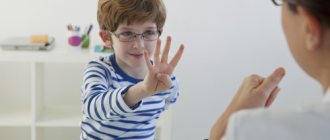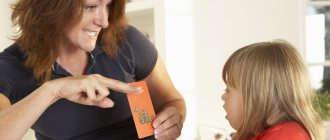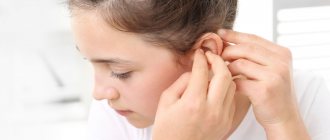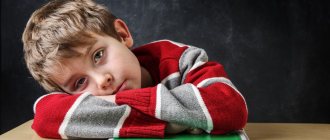Types of aphasia, causes and correction of aphasia
What is aphasia?
How serious is this speech pathology? Forms of aphasia: motor, sensory and total aphasia. Aphasia correction in Almaty. What are the causes of aphasia? Can aphasia be corrected? Is it possible to help adults with aphasia, or how successfully can aphasia be corrected in children? You will find detailed answers to all these questions in this article. Aphasia is one of the complex speech deviations of organic, central origin. The disorder, unlike other disorders, is caused by damage to the areas of the brain responsible for speech. The causes of such damage may be deterioration of blood circulation in the brain, traumatic brain injury, rheumatoid heart defects, thromboembolism, strokes, etc. Aphasia usually develops in people of old age, but can also affect young people and children.
With aphasia, partial speech impairment or complete loss may be observed.
The term "APHASIA" comes from the Greek language. The particle “a-” means negation, “phasis” means speech.
Aphasia appears when a person has already fully formed speech as a result of damage to the speech areas of the brain: the frontal, parietal, and temporal lobes.
Causes of aphasia
The main causes of aphasia:
- traumatic brain injuries;
- hemorrhages;
- inflammation, infectious diseases of the brain (meningitis, encephalitis);
- tumor formations;
- deterioration of blood circulation in the brain as a result of problems with blood vessels.
The severity of speech impairment depends on:
- extent of damage;
- features of deterioration of blood circulation in brain tissue;
- states of brain areas that take on the functions of the affected centers.
Forms of aphasia
Studying aphasia, scientists, including A. R. Luria, E. S. Bein, V. M. Kogan, identified the following forms of aphasia:
- motor aphasia – the patient loses the ability to speak;
- sensory aphasia – speech understanding deteriorates;
- total aphasia - the patient can neither speak nor understand speech.
Most often, aphasia develops in adults, but cases of this pathology appearing in children are not uncommon. The most common motor and sensory aphasia is childhood.
Diagnostic methods
Before you begin to fix the problem, you need to correctly determine the cause of the problem. This will allow you to choose the direction of restoration work and carry out treatment. Examinations are prescribed by a neurologist.
An MRI (magnetic resonance imaging) or computed tomography scan can help determine the location of the problem. Knowing which areas of the cerebral cortex are damaged will help determine the work needed.
In the sensory form, Wernicke's area is affected; in the motor form, Broca's area is affected.
It is advisable to conduct an ultrasound of the brain vessels - this will reveal circulatory disorders.
A psychologist assesses the state of higher mental functions (HMF):
- memory;
- thinking;
- attention.
This is an important stage of the examination, as it makes it possible to determine secondary disorders. With visual agnosia, the patient sees an object, but is unable to recognize it. That is, he describes the chair and its functions, but cannot name it.
The speech therapist conducts pedagogical diagnostics. It is aimed at studying general, fine motor skills, and organs of articulation. With the motor form, apraxia appears - the inability to perform a series of movements.
During a conversation, shifts in syllables occur. In severe cases, the style of speech, that is, the patient does not use verbs, prepositions, his phrases are short and chopped off.
Written language diagnostics is carried out in school-age children. A text is given to copy, one sample with written letters, the other with printed letters. The third test is taking dictation. A reading test is required.
In a severe form of motor aphasia, a child is able to write down a word only if it is clearly pronounced in syllables - this is a manifestation of agraphia. With sensory input, the patient easily copies the text from the sample and reads it. But without auditory control it does not always sound crisp and clear.
First aid is provided in hospitals, where children are checked by a council of specialists. In early forms of aphasia, it is difficult to make a prognosis, since much depends on the degree of damage, the beginning of assistance, and the qualifications of specialists.
Motor aphasia
Motor aphasia is the most common. It occurs when Broca's speech motor center is damaged.
This form is characterized by complete or partial loss of the ability to speak.
A person with motor aphasia understands speech well. However, he cannot pronounce complex words and link them correctly into sentences. Most motor aphasics manage to pronounce random syllables and fragments of sentences. Usually the most frequently used words are saved. The patient is able to pronounce individual syllables and simple sentences; often inserted words appear in speech, for example “here”, “this”. A similar disorder is also known as embolphrasia (embolus - insertion, phrases - speech).
Most people with motor aphasia are not capable of spontaneous speech. As a result of damage to Broca's speech center, the trigger mechanism is disrupted and the person loses the ability to reproduce sounds, construct syllables, and words. But at the same time, most patients understand speech well.
Children with motor aphasia, as a rule, do not lose the ability to distinguish numbers and letters, and can add various words, their first name, and last name from a cut alphabet. Such children are aware of their problem and are usually very worried about it. Such children are very self-critical and aware of their own helplessness. They develop depression, which can worsen if the child is not understood.
Features of speech therapy assistance
It will take about five years of hard work to eliminate the disorder in adolescents. Only with a clear awareness of the defect and the desire to cope with it can significant improvement be achieved. Due to their age, children do not always understand the seriousness of the situation; they hope for a spontaneous cure and do not see the need for systematic treatment.
A specialist needs to develop all types of mental activity, develop motivation, the ability to plan, and practice movements. Every lesson should be interesting.
All material is selected taking into account the age of the child. For preschoolers and primary schoolchildren, modeling, design, drawing, and games are used. Children in the preparatory group are taught to read, write, form words from a split alphabet, and are given the basics of sound-letter analysis.
Schoolchildren have difficulties with orientation in time and space. Therefore, work is being done to develop mathematical concepts. Teenagers also have their foreign language skills restored.
Sensory aphasia
Sensory aphasia - this disorder develops against the background of poor speech perception . Pathology appears when Wernicke's center is damaged.
A person with sensory aphasia hears speech but does not understand it. This state is comparable to when you hear a foreign language.
There are several stages of sensory aphasia. Impaired perception can affect someone else's and one's own speech. Lack of understanding can also concern individual structures or be general and deep. Another problem is that a person with sensory aphasia forgets words he has already learned, which complicates treatment. Due to problems with phonemic hearing, a sick person loses control over his own speech, despite the fact that there are no problems with motor skills or the speech center in the brain. However, full-fledged speech activity is hampered by:
- lack of auditory control;
- problems with understanding speech.
Children suffering from sensory aphasia are significantly behind their peers in terms of verbal reproduction. Severe distortions in conversation are noted, and paraphasia (substitution of letters, syllables or words) occurs. Moreover, sensory aphasia is accompanied by writing and reading disorders. The child ceases to recognize the words he has written, can distinguish letters, but cannot understand the meaning of the entire word, phrase, or sentence. With sensory aphasia, the rhythm and melody of speech are usually not impaired.
How to recognize the disease?
Sensory aphasia syndrome has an important feature: this disease does not arise out of the blue, there must be a reason. The patient himself may not know about it, not attach importance to it, or, due to a speech disorder, may not be able to talk about it. Therefore, modern research methods come to the rescue: computer (CT) and magnetic resonance (MRI) tomography, electroencephalography, and, if necessary, contrast angiography, which will help identify vascular pathologies.
In fact, sensory aphasia is a symptom of deeper disorders. But often, after eliminating the causes, speech is not restored immediately. This happens when the cortex of the speech centers is destroyed irreversibly, and it takes time for other parts of the brain to take over the functions of this area. When doctors are convinced that there is no danger to the patient’s life and health, it is time for rehabilitation: these classes are designed to speed up the process of formation of new neural connections.
Difference between aphasia and other speech disorders
Aphasia differs from other speech disorders:
- with aphasia, unlike dyslalia, in addition to impaired pronunciation, the patient loses the ability to understand words;
- Unlike dysarthria, with aphasia there are no problems with tongue mobility. The activity of the articular apparatus in dysarthria is constantly limited;
- hearing loss – hearing impairment, with aphasia there are no auditory abnormalities;
- with aphasia, the child experiences mental retardation. It is secondary in nature, so this disorder should not be confused with mental retardation.
Diagnosis differentiation
Determining the exact speech disorder is not always easy. In speech therapy, there are different diseases that have certain characteristics. With dysarthria, the subcortical structures of the brain are affected, and problems with pronunciation arise. In aphasia, gross motor disturbances arise due to damage to areas of the cortex. Dysarthria is characterized by limited articulatory apparatus, which is observed in all situations.
The symptoms are similar to alalia, but these are two different diagnoses. Aphasia is the breakdown of speech that has begun to form normally. The child pronounces the sounds of early ontogenesis, constructs simple phrases, and accumulates a vocabulary. With alalia this does not happen - there are no words, syllables, sometimes only simple onomatopoeia (“ma”, “bibi”).
With aphasia, a normal level of physical hearing is noted. The child reacts to stimuli and extracts speech sounds from the environment.
If there are mental disorders - developmental delay, mental retardation, autism - aphasia is not diagnosed. Against this background, secondary defects may develop, but they do not lead to a similar problem.
Aphasia correction
There are two areas of aphasia correction: medical and speech therapy.
Medical treatment for aphasia involves treating the affected areas of the brain with medications. Medical treatment must be strictly under medical supervision.
Speech therapy correction of aphasia involves conducting specialized sessions with the patient. Practice shows that children are much more amenable to learning than adults.
Unfortunately, not all adults with aphasia are able to recover from the disorder. In contrast, the disorder in children is much more amenable to correction and in a relatively short period of time it is possible to completely get rid of the pathology. But parents should remember that the earlier they start, the less likely it is that secondary disorders will occur.
Correction of aphasia is carried out using various techniques aimed at disinhibiting the speech system. One of the best techniques in this direction is to replenish the patient’s active and passive vocabulary. Correctly, correction of motor aphasia in children occurs in the form of individual lessons. It is necessary to take into account not only the complexity of the pathology, but the character of each child. Moreover, the acquired skills are unstable, so it is necessary to periodically consolidate the material covered.
Features of aphasic disorders in children and adolescents with traumatic brain injury
Traumatic brain injuries (TBI) account for 40% of all traumatic injuries in humans. The consequences and complications of TBI are very diverse. The most common consequence of TBI is aphasia (systemic disorders of speech function) or dysarthria, which are often combined with pathology of other higher mental functions (HMF). A special problem in terms of theoretical study and its practical implementation is aphasia in children, including aphasia of traumatic etiology.
Descriptions of aphasia in children are available in the works of a number of authors (S.Yu. Benilova, T.G. Vizel, Yu.A. Mikadze, A.Yu. Obukhovskaya, A.V. Semenovich, E.G. Simernitskaya, N.N. Traugott, M. G. Khrakovskaya, L. S. Tsvetkova, etc.). Researchers note that the clinical picture of childhood aphasia has both similarities and differences with aphasia in adults.
The similarities are as follows. In both children and adults, aphasia occurs due to the same etiological factors. The most common injury in children is traumatic brain injury. Aneurysm ruptures occur less frequently, as do tumors; even less common are strokes (in contrast, in adults strokes occupy a leading place). The similarity between children's and adult aphasias also lies in the fact that in both groups there is a disintegration of already formed speech. Hence the identity of many symptoms of aphasia in children and adults, as well as the presence in the acute period of the disease of a significant amount of neurodynamic disorders that obscure the main syndrome.
The differences between childhood and adult aphasia relate, first of all, to the degree of persistence of speech pathological symptoms. Speech disorders in children are less persistent than in adults, are observed more often in the acute period of the disease and have a relatively rapid reverse development. As is known, this is associated with the high plasticity of the child’s brain, in which the functional activity of interzonal connections, rarely mentioned in the literature, is important.
Despite the existing developments, the problem of aphasia in children and adolescents is still insufficiently studied, especially with regard to the processes of correctional and restorative education.
The most common and recognized is the classification of aphasia by A.R. Luria, which includes: afferent motor, efferent motor, dynamic, sensory (acoustic-gnostic), acoustic-mnestic, semantic. Semantic aphasia is most rarely detected in children and adolescents due to the immaturity of the tertiary zone of overlap of the cerebral cortex (TPO zone) in childhood. The diagnosis of semantic aphasia is valid after the age of 12-13 years.
Unfortunately, in the acute period it is not always possible to conduct a full speech therapy examination due to the severity of the patients’ condition or their increased exhaustion. In children, these features of the acute period of the disease are expressed to an even greater extent due to the immaturity of the HMF, as well as the emotional-volitional sphere. This determines that in most cases the speech therapist conducts a blitz examination, aimed primarily at identifying speech disorders, using various modified diagnostic scales. The following is assessed: the state of the pronunciation side of speech, understanding of addressed speech, the level of the state of oral speech, reading, writing, oral and articulatory praxis, and not only a qualitative analysis is carried out, but also a quantitative assessment in points, for a visual representation of the dynamics of recovery. The degree of complexity of the diagnostic material varies depending on the age of the child and the level of development of his speech and other HMF. For some, in particular preschoolers, it is advisable to select simplified diagnostic techniques similar to standard speech therapy examinations of children with ODD. The observation method is also used. The diagnostic procedure is preceded by the collection of anamnestic information about the physical and psycho-speech development of the child. Particular attention is paid to the extent to which he spoke before the injury. In this case, it is necessary to take into account the age parameters of the maturation of HMF.
Diagnostics, depending on the patient’s condition, can take from 10 to 40 minutes. Based on the diagnostic results, the speech therapist determines the form of speech disorders in the patient, the degree of their severity (mild, moderate, severe) and the leading defect; evaluates the characteristics of neurodynamic processes.
According to Simernitskaya E.G. the clinical picture of speech disorders in children becomes similar to aphasia in adults from the age of 6 years. Before this age, speech disorders are similar to alalia, although the child’s speech development before the traumatic impact on the brain could be normal; after a TBI, speech is impaired, but the diagnosis of “aphasia” is made only when the child’s speech is already formed. In the case where the child had a history of speech development delays like alalia before the TBI, after the injury the clinical picture of speech worsens. Experience also shows that speech impairments in preschoolers are more difficult to recover. According to parents, emotional and behavioral disorders appear or worsen: children become more capricious, and even more often aggressive. At the same time, it has been established that all children have higher compensatory capabilities than adult patients. The plasticity of the children's brain allows them to overcome disorders in a shorter time and achieve positive dynamics earlier. Currently, rehabilitation departments often receive patients who are bilingual and whose speech communication is impaired in both their native and non-native languages. Care for such patients should be provided either in their native language or in both languages. According to our observations, assistance in a language other than one’s native language is not sufficient to correct speech disorders.
Restoring speech function in any form of aphasia requires a systematic approach, i.e. implies the normalization of all disturbed systems of speech function, as well as the non-speech HMFs that are basic to it. It has been established that the earlier speech therapy work is started, the better its final result, so rehabilitation begins in the first days, when even the most minimal contact with the child becomes possible. The principles and techniques of working with various forms of aphasia are described in the literature. With adolescents, techniques and methods developed for adult patients are used (it is possible to use all benefits for the recovery of aphasic disorders). When working with preschoolers, preference is given to gaming techniques: games, physical exercises, finger exercises, elements of dramatization (fairy tales, skits using toys), logorhythmics.
Purpose of the study: to study the characteristics and dynamics of aphasia in children and adolescents with severe and moderate traumatic brain injury.
Materials and methods of research.
The study was conducted on the basis of the Scientific Institute of Emergency Pediatric Surgery and Traumatology (Research Institute of Pediatric Surgery and Traumatology). 20 children with traumatic etiology of aphasia were examined. The children were distributed by age and gender as follows: from 4 to 17 years old - 5 girls and 15 boys, among them 4 preschool children.
The following methods were used:
- Diagnosis of the state of speech function and other HMFs using a complex neuropsychological technique using diagnostic schemes by A.R. Luria, L.S. Tsvetkova, V.M. Shklovsky and T.G. Wiesel, including non-speech and speech scales.
- Corrective and remedial training.
Results.
In all children and adolescents in the most acute period, predominantly gross motor aphasia and gross sensory aphasia were noted, which subsequently manifested themselves in different clinical pictures. Among them, complex motor aphasia of varying degrees of severity predominated (in 17 children - 85% of the total number studied). The remaining children had: 1) acoustic-mnestic aphasia (in 12 children - 60%), the peculiarity of which was that it most often manifested itself as part of the amnestic syndrome; 2) dynamic aphasia (in 3 children - 15%), which usually manifested itself as part of the frontal syndrome. Two left-handed children (10%) had aphasia that was unrecognizable in the acute period.
The study confirmed and clarified the ideas that: 1) in children, just like in adults, neurodynamic disorders and disorders of executive functions (mostly in the levels of control and regulation) are clearly visible, which “noise” the true picture of a speech defect ; 2) in the process of rehabilitation training, neurodynamic disorders are leveled out faster than in adults. In addition, we found that neurodynamic difficulties go away somewhat faster than difficulties in executive functions.
The next result is the statement that gross sensorimotor aphasia regressed more quickly in children, especially its sensory component. Among the more persistent disorders were motor (with a predominance of the efferent component), as well as acoustic-mnestic disorders. It was also found that all children with TBI had amnestic disorders, mainly in the auditory-speech modality. All children, regardless of the form of aphasia, showed a violation of the nominative function, and the updating of the predicative vocabulary was carried out much better than the nominative one - even in children with motor aphasia.
Written speech and sound-letter analysis suffered in all children, regardless of age and form of aphasia. This also applies to the inferiority of dynamic praxis (in the form of deautomation of praxic actions). Disturbances in kinesthetic hand and finger praxis were less pronounced. Children with dynamic aphasia, like adults, showed significant impairments in speech communication.
In terms of recovery, preschool children, as well as children of primary and secondary school age, showed high positive dynamics in the restoration of speech and other HMF; In children of high school age, the symptoms of aphasia were similar to the dynamics of regression of aphasia in adults. This concerns not only the specific manifestations of aphasia, but also the well-known fact that serious difficulties arise in communication with others and socialization in general.
An analysis of the characteristics of the restoration of speech function in patients showed that the optimal teaching tactic is to follow its phased approach. At the early stages, the task was set to include involuntary, automated levels of speech activity. At subsequent stages of the disease, correctional and restorative training used restructuring techniques. This once again demonstrates: a) the compensatory activity of brain mechanisms in the early postmorbid stages due to vicariate reserves, as well as the inclusion of interzonal connections in compensatory processes; b) the need to search for brain mechanisms to bypass the primary defect in more distant periods of the disease.
Summarizing the results of the study, we can conclude that they basically confirmed the existing ideas about the features of the course of childhood aphasia, their similarities and differences with the features of the course of aphasia in adults. We regard the new data we have received on:
- quantitative and age distribution of forms of aphasia in children;
- patterns in the severity of individual symptoms;
- greater activity of interzonal connections in children than in adults;
- compliance with stages in rehabilitation training;
- methodological content of each of the recovery stages.
Let us give a clinical example from speech therapy practice.
Boy, Luke (4 years old).
The boy was admitted to the rehabilitation department with a diagnosis of consequences of traumatic brain injury (moderate brain contusion, comminuted fracture of the left parietal bone).
In the child's speech status, pronounced difficulties were detected, in the motor sphere - right-sided hemiparesis (more in the hand). In the emotional sphere, the child showed increased lability, fatigue, exhaustion, fluctuations in capabilities, and inactivity. At home, according to his parents, after the injury, the boy began to be capricious more often, cry, refuse to do many things that he had previously done with pleasure (he began to play less, got more tired, could scream if he didn’t like something, due to hemiparesis he could not used his right hand when performing everyday activities). In his premorbid status, Luka had well-developed speech in accordance with the age norm; he is a very active and inquisitive boy, right-handed (his relatives are also right-handed).
Objectively during examination: Luka in the situation of examination has adequate behavior, is contactable, criticism is reduced. Inertia, exhaustion, inactivity, an increase in the latent period, and fluctuations in capabilities are noted. Complaints from the mother about speech disorders, slowness in all types of activities.
Swallowing was preserved, chewing was normal. Violations of the muscle tone of the organs of articulation are revealed. The face is hypomimic. Tongue - dystonia. The voice is dull, poorly modulated. Speech exhalation is shortened. Salivation is moderate. Sound pronunciation - replacement of some sounds (as a variant of dysontogenesis in the form of erased dysarthria, as well as a phenomenon of afferent apraxia). Speech intelligibility in the speech stream is slightly reduced. The rate of speech is slow, the rhythm is disturbed.
Impressive speech. Speech understanding is preserved. Display of objects is difficult and confusing in places. The perception of extended speech is somewhat slow.
Expressive speech. Own speech is possible, but difficult and meager. Speech activity is reduced. According to the mother, before the injury he had phrasal speech, the child loved to perform various developmental tasks. Difficulties in organizing a monologue utterance, perseveration (repetitions of sounds, syllables and simple words), agrammatisms, permutations, and rare paraphasias are identified. Repetition of words and phrases - with rearrangements of sounds and syllables, perseverations, omissions of sounds. Naming is possible. Responses are often latent. Writing a story is difficult. Non-verbal tasks (with the help of picture material) are carried out well.
Speech therapy status: motor alalia, dysarthria, neurodynamic disorders.
Remedial training program:
- Correction of phrasal speech.
- Correction of the pronunciation side of speech, voice characteristics.
- Development of phonemic analysis.
After a course of rehabilitation training in the rehabilitation department, Luka’s speech status showed a pronounced positive trend. Luka began to use his right hand more actively (more often he began to pick up objects and pictures in his right hand in class), the neuropsychologist recommended that he develop fine motor skills at home and remind the boy to include his right hand in activities (if he is capricious, do not insist). The boy became calmer, emotional lability and exhaustion decreased (both at home and in class), active performance increased, Luka began to ask less often “will class end soon?”, and became less distracted. Face - facial expressions have become more animated. The performance of voluntary articulatory movements has improved, however, pathological synkinesis during tongue movements remains. The strength of the voice increased, the modulations became more pronounced. The voice became more sonorous. Speech active exhalation became smoother and longer. Salivation is moderate. In the speech stream, speech intelligibility improved. Sound pronunciation remains blurred, complex words are pronounced at a slow pace, with rearrangements and replacements of sounds. The sound “l” is inserted, although in speech the hard sound is still replaced by a soft one (“l” - “l”). The rate of speech became faster, closer to normal, the rhythm was maintained.
Impressive speech. Speech understanding is preserved. I became better able to retain presented elements in my auditory-verbal memory.
Expressive speech. Your own speech is possible, the phrase has become more developed, more words have been updated. Perseverations began to be observed less frequently, agrammatisms (characteristic of efferent apraxia), rearrangements of sounds and syllables, and rare paraphasias were noted.
Upon discharge, the boy showed positive changes in all areas of activity and, in particular, in speech. To further restore the boy’s speech function, the parents were recommended to continue speech therapy classes at their place of residence and in rehabilitation departments. This is extremely important, given the fact that Luke’s speech was not yet fully formed, but was in a stage of development.
Thus, all of the above and the example given leave no doubt that the development of the problems of aphasia in children, including traumatic etiology, is far from complete. It is necessary to further study it, and above all, to search for special methods and techniques of restorative training that would help more effectively and efficiently overcome the aphasic disorders that children have.
The procedure for correcting motor aphasia
Speech therapy correction of aphasia includes:
- practicing articular differentiations;
- classes aimed at improving pronunciation;
- development of vocabulary, classes to improve speech understanding;
- correction of speech coherence;
- getting rid of speech and writing defects.
For aphasia correction to be successful, it is important to develop auditory analysis skills from the very beginning. The child should be able to easily identify the necessary sounds and determine the positions in which they are located. The main task of correction is to revive the speech analyzer. Therefore, first of all, a speech therapist works with preserved sounds.
The next step is to restore the missing sounds. The acoustic, articular and graphic components of each sound are carefully studied. Classes are very useful, the essence of which is the combined (together with a speech therapist) repetition of speech series, for example, BA-PA, PA-BA, etc.
Later, as classes progress, words and phrases are formed from syllables. If the patient is already in school, then the aphasia correction course additionally includes exercises to improve writing skills, the entire oral cycle is repeated in writing. During written speech correction, each word is analyzed, broken down into sounds and letters, and exercises are given. For example, a child needs to find and restore a missing letter, answer a question in writing, complete a word, etc.
Treatment methods
To eliminate aphasia, two directions are used - speech therapy and medical. The neurologist prescribes a course of medications that dilate blood vessels, improve metabolism and blood circulation. Additional means stimulate the functioning of the nervous system - these are physical therapy, massage, physiotherapy.
Aphasia can be characterized by different manifestations, so the speech therapist prepares correctional work based on the individual characteristics of the patient. The work is carried out under the supervision of the attending physician, since the deterioration of the child’s condition (decreased speech functions) indicates an increase in blood pressure and the development of other problems.
The first classes last 10 minutes, gradually increasing the time. It is important not to overload the patient. A personal notebook is created for each child, where information about the lesson is recorded.
Group classes are used whenever possible. They restore the communicative function of speech, remove phobias and fears. Children are selected in groups of 3-4 with approximately the same degree of defect. For sensory learners, groups consist of 2-3 people.
For motor aphasia, everyday themes and home dramatizations are widely used. At the beginning of the lesson, the speech therapist clearly outlines the lesson plan.
There are special kindergartens for preschool children, and a Type V school for schoolchildren. In educational institutions they are provided with all the necessary assistance.
Correction of sensory aphasia
Correcting sensory aphasia is very difficult, and the whole process can take quite a long time.
Correction of sensory aphasia includes:
- development of phonemic awareness. At first, the child needs to recognize sounds by ear, for example, rustling, knocking;
- restoration of speech understanding. At this stage, work is carried out to improve the pronunciation of words that sound similar but have different meanings. For example, a ball-ball, etc.
- developing the ability to analyze speech by ear (your own and others). Students are also given written assignments as well as reading exercises.
People suffering from sensory aphasia find it very difficult to perceive verbal information by ear. Therefore, when reproducing material, oral dictation must be accompanied by visual and graphic information.
A correction plan for sensory aphasia is developed individually. Classes are developed based on the etiology, age of the child, and the extent of damage to brain areas.
Bringing speech back
Correction of sensory aphasia primarily includes drug support - continued treatment of the disease that led to the speech disorder. The primary treating physician for such patients is a neurologist. Its task is not only to monitor the continuation of treatment, but also to monitor whether other neurological disorders develop, which may either be a consequence of a previous illness or injury, or arise for other reasons. The doctor decides which medications are used individually in each case. If you want to add something to your treatment (most often you want to add vitamins), be sure to discuss this with your doctor! Accurate implementation of the neurologist’s prescriptions is the basis for success in speech rehabilitation.
An important component of treating sensory aphasia is working with a speech therapist. It happens, especially in children, that speech is restored on its own, but no one can predict whether this will happen or not. Therefore, remedial training for sensory aphasia is an essential part of therapy. The speech therapist will teach parents what exercises to do at home and what to watch for so that rehabilitation goes faster and more successfully. The main task of relatives is to organize a comfortable environment for the patient and learn to communicate with him. The exercises that the speech therapist asks you to do at home will help with this. Don’t force things, the brain needs time to restore neural connections. It is extremely important to dose the load; overwork will not benefit the baby.
Our center’s specialists have extensive experience in restoring lost speech in children. They are familiar with methods that are recognized as effective by the global speech therapy community, and choose from a variety of methods those that will work best for a particular child. We achieve results whenever this is possible in principle - and in children it is possible to restore lost speech in most cases.
Disinhibition of speech at the initial stages of aphasia development
The most effective method of eliminating aphasia and preventing the problem from worsening is to bring speech sequences to an automatic level by performing exercises such as singing, repeating phrases, finishing sentences, tongue twisters, etc.
When disinhibiting, the speech therapist completely pronounces the sentence to the last word, pronouncing only one syllable. The patient’s task is to finish the last word. First, the speech therapist examines the patient, determines what is easier for the patient, verbs, nouns, adjectives.
For example: the goat bleats, and the dog ... (barks); grass in the yard, firewood on the grass); Summer, sun, ... (heat); take matches, light... (fire).
Also, when disinhibiting, it is possible to achieve very good results using sayings. For example: you can’t even pull a fish out of ... (pond) without difficulty.
If such exercises cause difficulties for the patient, and more often than not, the song helps. The speech therapist begins to sing and when the patient begins to recognize the song, a smile spreads across his face.
Dialogical work
Our main work in the correction of aphasia is dialogic speech.
Scheme of work in this direction:
- the patient repeats the prepared answer phrase;
- the speech therapist prompts the first one or two syllables, and the patient must complete the word or phrase;
- the patient must select one or more words from those spoken by the speech therapist;
- the patient must answer the speech therapist’s question without prompting.
Remember, aphasia is treatable. If in adults the recovery process is difficult and takes a lot of time, then in children aphasia is treated quite quickly and effectively. The use of effective techniques, songs, and negotiation exercises significantly accelerates the patient’s process of developing coherent speech.
Our speech pathologists and speech pathologists conduct speech therapy classes in Almaty for the correction of aphasia in both adults and children. If you need help or advice, please contact us!










